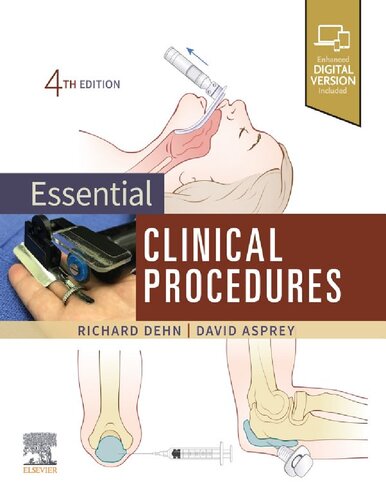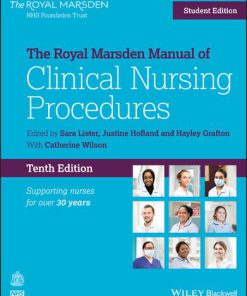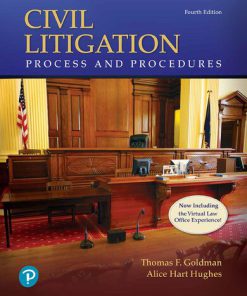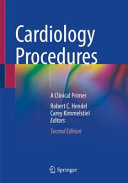Essential Clinical Procedures 4th Edition by Richard Dehn, David Asprey ISBN 9780323624688 0323624685
$50.00 Original price was: $50.00.$25.00Current price is: $25.00.
Essential Clinical Procedures 4th Edition by Richard Dehn, David Asprey – Ebook PDF Instant Download/Delivery: 9780323624688 ,0323624685
Full download Essential Clinical Procedures 4th Edition after payment

Product details:
ISBN 10: 0323624685
ISBN 13: 9780323624688
Author: Richard Dehn, David Asprey
Provide safe and effective care to every patient with the fully revised 4th Edition of Essential Clinical Procedures . Written by experts in the field, this widely used reference shows you step by step how to perform more than 70 of the most common diagnostic and treatment-related procedures in today’s primary care and specialist settings. You’ll find clear, concise coverage of the skills you need to know , including new and advanced procedures and new procedure videos .
Essential Clinical Procedures 4th Edition Table of contents:
Chapter 1: Anoscopy
Abstract
Background and History
Indications
Contraindications
Potential Complications
Essential Anatomy and Physiology
Patient Preparation
Materials
Follow-Up Care and Instructions
Chapter 2: Arterial Puncture
Abstract
Background and History
Indications
Contraindications
Potential Complications
Essential Anatomy and Physiology
Patient Preparation
Materials
Special Considerations
Follow-Up Care and Instructions
Chapter 3: Blood Pressure Measurement
Abstract
Introduction
Background and History
Indications
Contraindications
Potential Complications
Essential Anatomy and Physiology
Patient Preparation
Selecting Proper Cuff Size
Time of Measurement
Training and Competencies
Materials for Blood Pressure Measurement
Special Considerations
Assessment of Orthostatic Blood Pressure
Materials for Measuring Orthostatic Blood Pressure
Follow-Up Care and Instructions
Chapter 4: Casting and Splinting
Abstract
Background and History
Indications
Contraindications
Potential Complications
Expected Outcomes
Essential Anatomy and Physiology
Patient Preparation
Materials
Materials Used for Applying a Short-Arm Cast
Materials Used for Applying a Short-Leg Cast
Materials Used for Applying a Short-Arm Ulnar Gutter Splint
Materials Used for Applying a Short-Leg Posterior Mold Splint
Materials Used for Applying a Lower Leg Sugar Tong Splint
Follow-Up Care and Instructions
Future Considerations
Chapter 5: Cryosurgery
Abstract
Background and History
Indications
Contraindications
Potential Complications
Essential Anatomy and Physiology
Patient Preparation
Materials
Special Considerations
Follow-Up Care and Instructions
Chapter 6: Dermatologic Procedures
Abstract
Biopsy
Materials Used to Perform a Shave or Saucerization Biopsy
Materials Used to Perform a Snip Biopsy
Materials Used to Perform a Cure ttage
Punch Biopsy
Materials Used to Perform a Punch Biopsy
Excisional Biopsy
Materials Used to Perform an Excisional Biopsy
Electrosurgery
Materials Used to Perform Electrosurgery
Acne Surgery
Materials Used to Perform Acne Surgery
Chapter 7: Draining/Evacuation of Subungual Hematomas
Abstract
Background and History
Indications
Contraindications
Potential Complications
Essential Anatomy and Physiology
Patient Preparation
Materials
Special Considerations
Follow-Up Care and Instructions
Disposal of Materials
Chapter 8: Endometrial Biopsy
Abstract
Background and History
Indications
Contraindications
Potential Complications
Essential Anatomy
Anatomy, Physiology and Pathophysiology
Patient Preparation
Materials
Follow-Up Care and Instructions
Supplementary and Alternative Procedures
Chapter 9: Endotracheal Intubation
Abstract
Background and History
Indications
Contraindications
Potential Complications
Essential Anatomy and Physiology
Patient Preparation
Pharmacology
Local Anesthetics
Other Methods of Anesthesia
Neuromuscular Blocking Drugs
Nondepolarizing Neuromuscular Blockade Agents
Physical Preparation
Follow-Up Care and Instructions
Chapter 10: Epistaxis and Nasal Foreign Body Removal
Abstract
Epistaxis
Essential Anatomy and Physiology
Cause of Nasal Bleeding and Pathophysiology
Patient Preparation
Materials
Follow-Up Care and Instructions
Nasal Foreign Body Removal
Essential Anatomy and Physiology
Materials
Follow-Up Care and Instructions
Chapter 11: Foot Examination of the Patient With Diabetes
Abstract
Background and History
Indications
Contraindications
Potential Complications
Review of Essential Anatomy and Physiology
Patient Preparation
Materials Utilized for Performing the Diabetic Foot Examination
Special Considerations
Follow-Up Care and Instructions
Chapter 12: Incision and Drainage of an Abscess
Abstract
Background and History
Indications
Contraindications
Potential Complications
Essential Anatomy and Physiology
Clinical Evaluation
Treatment
Source of Infection
Patient Preparation
Materials
Special Considerations
Pain Relief
Follow-Up Care and Instructions
Chapter 13: Injections
Abstract
Background and History
Indications
Contraindications
Potential Contraindications
Potential Complications
Essential Anatomy and Physiology
Patient Preparation
Materials
Special Considerations
Documentation and Follow-Up Care
Chapter 14: Inserting Intravenous Catheters
Abstract
Background and History
Indications
Contraindications
Potential Complications
Essential Anatomy and Physiology
Patient Preparation
Materials
Special Considerations
Follow-Up Care and Instructions
Chapter 15: Joint and Bursal Aspiration
Abstract
Background and History
Indications
Contraindications
Potential Complications
Essential Anatomy and Pathophysiology: Joint Aspiration
Patient Preparation: Joint Aspiration
Materials Used for Performing Joint and Bursal Aspiration
Follow-Up Care and Instructions: Joint Aspiration
Essential Anatomy and Physiology: Bursal Aspiration
Patient Preparation: Bursal Aspiration
Follow-Up Care and Instructions: Bursal Aspiration
Chapter 16: Local Anesthesia
Abstract
Background and History
Essential Anatomy and Physiology
Indications
Contraindications
Potential Complications
Patient Preparation
Materials Used for Administering Anesthetics
Follow-Up Care and Instructions
Chapter 17: Lumbar Puncture
Abstract
Background and History
Indications
Contraindications
Potential Complications
Essential Anatomy and Physiology
Patient Preparation
Materials
Special Considerations
Follow-Up Care and Instructions
Chapter 18: Nasogastric Tube Placement
Abstract
Background and History
Indications
Contraindications
Potential Complications
Essential Anatomy and Physiology
Patient Preparation
Materials
Special Considerations
Follow-Up Care and Instructions
Chapter 19: Obtaining Blood Cultures
Abstract
Background and History
Indications
Contraindications
Potential Complications
Essential Anatomy and Physiology
Patient Preparation
Materials
Special Considerations
Follow-up Care and Instructions
Disposal of Materials
Chapter 20: Office Pulmonary Function Testing
Abstract
Background and History
Indications
Contraindications and Patient Considerations
Potential Complications
Essential Anatomy and Physiology
Patient Preparation
Materials
Special Considerations
Follow-Up Care and Instructions
Chapter 21: Introduction to Point-of-Care Ultrasonography (POCUS)
Abstract
Background and History
Indications
Pro Tips and Trouble Shooting
Chapter 22: Procedural Sedation
Abstract
Background and History
Definitions
Indications
Contraindications
Potential Complications
Patient Preparation
Essential Anatomy and Physiology
Materials
Monitoring
Agents for Procedural Sedation
Discharge Criteria
Chapter 23: Recording an Electrocardiogram
Abstract
Background and History
Indications
Long-Term ECG Recording
Contraindications
Potential Complications
Essential Anatomy and Physiology
Patient Preparation
Materials
Special Considerations
Follow-Up Care and Instructions
Chapter 24: Reduction of the Shoulder/Finger Subluxations
Abstract
Shoulder Subluxation or Dislocation
Finger Subluxation or Dislocation
Distal Interphalangeal Joint
Metacarpophalangeal Joint
Referral Decisions
Chapter 25: Removal of Cerumen and Foreign Bodies From the Ear
Abstract
Background and History
Indications
Contraindications
Potential Complications2,6,10
Essential Anatomy and Physiology
Patient Preparation
Materials
Special Considerations
Follow-Up Care and Instructions
Chapter 26: Ring Removal
Abstract
Background and history
Indications
Contraindications
Potential complications
Essential anatomy and physiology
Patient preparation
Materials
Special considerations
Standard precautions
Follow-up care and instructions
Disposal of materials
Chapter 27: The Pelvic Examination and Obtaining a Routine Papanicolaou Smear
Abstract
Background and History
Indications
Contraindications
Potential Complications
Essential Anatomy and Physiology
Internal Anatomy
Patient Preparation
Materials
Special Considerations
Follow-Up Care and Instructions
Interpretation of the Pap Test
Chapter 28: Trauma-Oriented Ocular Examination, Corneal Abrasion, and Ocular Foreign Body Removal
Abstract
Background and History
Indications
Contraindications
Cautions and Considerations
Complications
Essential Anatomy and Physiology
Patient Preparation
Materials
Special Considerations
Follow-Up Care and Instructions
Patient Discharge Instructions for Corneal Abrasion
Chapter 29: Treating Ingrown Toenails
Abstract
Background and History
Indications
Contraindications
Potential Complications
Essential Anatomy and Physiology
Patient Preparation
Materials
Follow-Up Care and Instructions
Chapter 30: Urinary Bladder Catheterization
Abstract
Background and History
Indications
Contraindications
Potential Complications
Essential Anatomy and Physiology
Patient Preparation
Materials
Types of Catheters
Catheter Size Requirements
Follow-Up Care and Instructions
Chapter 31: Venipuncture
Abstract
Background and History
Indications
Contraindications
Potential Complications
Essential Anatomy and Physiology
Patient Preparation
Materials
Special Considerations
Follow-Up Care and Instructions
Disposal of Materials
Chapter 32: Wound Closure
Abstract
Background and History
Indications
Contraindications
Potential Complications
Essential Anatomy and Physiology
Classification of Wounds
Wound Closure Classification
Patient Preparation
Materials Used for Performing Irrigation, Cleansing, and Debridement
Suture Selection
Other Instruments
Special Considerations
Materials Used for Using Skin Staplers
Materials Used for Applying Wound Adhesives
Follow-Up Care and Instructions for Sutured or Stapled Wounds
Suture Removal
Staple Removal
Follow-Up Care and Instructions for Adhesive-Closed Wounds
Example of a Wound Closure Procedure Note
Disposal of Materials
Chapter 33: Wound Dressing Techniques
Abstract
Background and History
Indications
Contraindications
Essential Anatomy and Physiology
Wound Healing
Prevention of Infection in Wounds
Patient Preparation
Materials
Negative-Pressure Wound Therapy
Follow-Up Care and Instructions
Conclusion and Resources
Chapter 34: Informed Consent
Abstract
Brief History of Informed Consent
The Clinician-to-Patient Relationship: An Enduring Bond
The Four Cs: Capacity, Competency, Clarity, and Consent
Minors
Standards of Disclosure
Types of Consent
Capacity Concerns
Handling Patient Lack of Capacity
A Long View of Informed Consent: When Consent Lives On and On
Codes of Ethics
Chapter 35: Standard Precautions
Abstract
Background and History
Body Substance Isolation
Universal Precautions
Standard Precautions
Gloves, Gowns, Masks, and Other Protective Barriers as Part of Universal Precautions
The Application of Standard Precautions in Clinical Procedures
Chapter 36: Sterile Technique
Abstract
Statements
Background and History
Indications and Principles of Sterile Technique
Contraindications and Potential Complications
Patient Preparation
Materials
Special Considerations
Follow-up Care and Instructions
Disposal of Materials
Chapter 37: Patient Education Concepts
Abstract
Background and History
A Model for Patient Education
Appropriate use of Interviewing Techniques
Specific Suggestions for Enhancing the Patient Education Process
Other Factors Influencing Patient Education
Conclusion
Chapter 38: Outpatient Coding for Medical Services
Abstract
Background and History
Purpose of Accurate Medical Record Documentation
The Outpatient Coding Process
Criteria in Selecting the Proper Evaluation and Management Service Codes
Historical Data Collection
Example A
Example B
Medical Decision-Making
Types of Medical Decision Making
Example C
Other Contributing Factors in Documentation and Coding of Patient Encounters
Summary
Chapter 39: Procedural Notes and Documentation
Abstract
Background and History
Other Points for Consideration in Recording Clinical Procedures
Clinical Procedure Notes
Clinical Procedure Note Format
Conclusion
Chapter 40: Giving Sad and Bad News
Background and History
Indications
Preparing to Share Bad News
A Procedure for Sharing Bad News
Disbelief
Shock
Denial
Fear and Anxiety
Guilt
Depression
Crying and Tears
Awkward Question
Sad and Bad News Presented to Children
Conclusion and Further Thoughts
Index
People also search for Essential Clinical Procedures 4th Edition:
essential clinical procedures for veterinary technicians
dehn essential clinical procedures
essential clinical procedures pdf
essential clinical procedures 4th edition pdf
essential clinical procedures for veterinary technicians ebook
Tags:
Richard Dehn,David Asprey,Essential Clinical Procedures
You may also like…
Medicine - Cardiology
Cardiology Procedures: A Clinical Primer 2nd Edition Robert Hendel (Editor)
Mathematics
Essential University Physics Volume 1 4th Edition by Richard Wolfson ISBN 1292360410 9781292360416
Science (General) - Research & Development
Meta analysis in Clinical Research Principles and Procedures Anoop Kumar
Science (General) - Research & Development
Jurisprudence & Law - General & Miscellaneous Law
Medicine - Cardiology
Cardiology Procedures A Clinical Primer Second Revised Edition Robert C Hendel Carey Kimmelstiel











